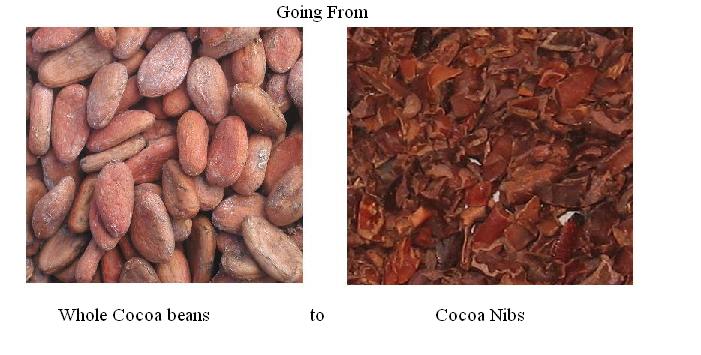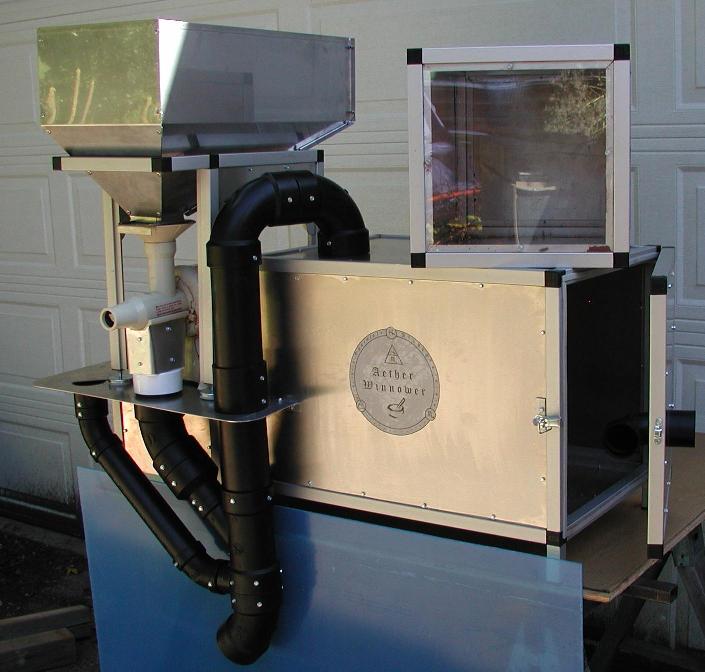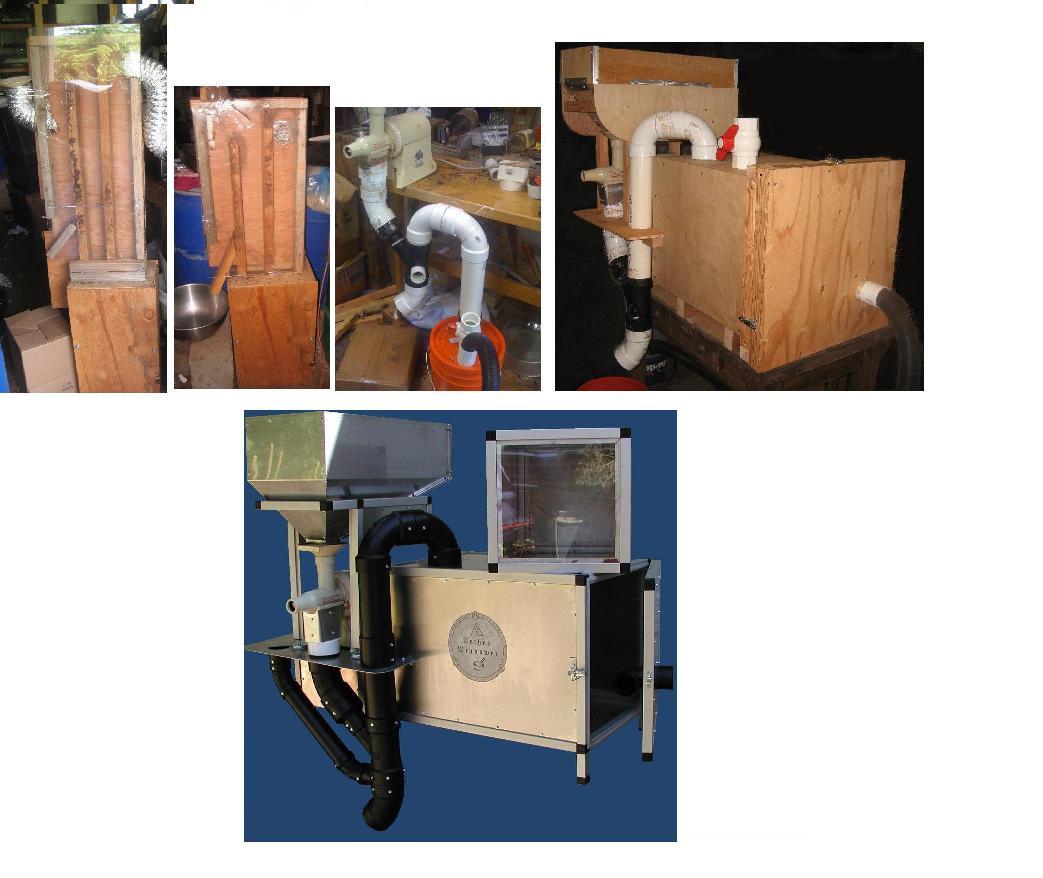To make chocolate, this husk must be removed from the cocoa bean. The goal here is to crack the cocoa beans into pieces and then separate (winnow) the husk from the nib.
Cracking
It can be done by hand, but this is rather tedious and not very approachable. Like most things, there are many things that do not work, and only a few that do work. Here's a basic list of various ways you can and can not crack cocoa beans.
Do not work for Cracking:
- Meat Grinders
- Food processors
- Grain mills
- Coffee grinders
Works OK, but not great or not feasible
- Hand peeling
- Corona type
Works Great
- Crankandstein Cocoa Mill
- Champion Juicer w/o bottom screen (see it attached to the Aether below)
After proper roasting, you will notice the outer husk is much looser and easier to remove. It sounds simple enough but just a few years ago, there were no equipment that worked off the shelf. I contacted two companies to see if they had any interest in modifying one of their products to handle cocoa beans. Crankandstein worked with Chocolate Alchemy and the Crankandstein Cocoa mill was born - a heavy three roller, dual drive, set gap mill. You can see it in action below. It is a breeze to crank and easily does 4 lbs/min. It also has a 1/2" shaft that will fit most drill chucks if you with to motorize it.
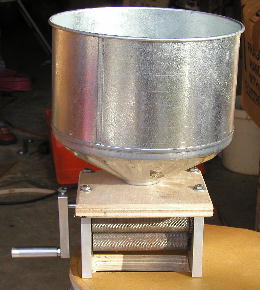

Crankandstein Cocoa Mill The Mill loaded with 4 lbs of Cocoa beans
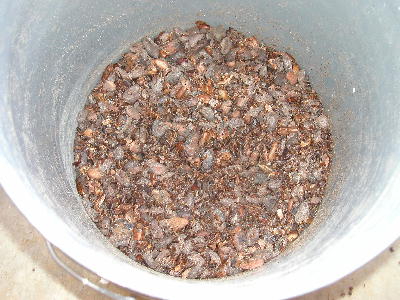
1 minute later 4 lbs of cracked cocoa beans
Also, the mill does ok on the Raw cocoa beans. You can make your own raw nibs for adding to various raw food recipes (although personally I like the taste of roasted nibs much better). In this case, it usually takes two passes as the husk adheres to the beans more than when the cocoa beans are not roasted and raw nibs are harder to winnow than roasted.
- Champion Juicer - years ago I proposed separating (not really winnowing as no air is involved) the husk and nib as you grind. I technically will work if you are doing small 1-2 lb batches, but it is VERY hard on the Champion and the cocoa and not something I generally recommend any more. It's fine for a final filter (see below) but not the initial separation.
Works ok, but not great:
- Long tube PVC winnowers. There are various permutations of these winnowers. Some have one fan, some have two, some have speed controllers, some have valves, most (maybe all) are hand feed. Most work well for seeds, but none work simple and easy with a single pass and without a LOT of hands on user intervention.
- Hand peeling - 1 lb/ hour. 'nuff said. Well, I will say more. Works fine, but is slow, tedious, hard on the hands and not approachable.
Works Good:
- Bowl/Blow dryer Method
- Sylph winnower
- Aether Winnower
Bowl/Blow dryer Method
The goal here is to blow the lighter husk away but leave the heavier nibs. It's a bit messy, and not good of indoors, but does a fine job. I recommend wearing a dust mask. There is definitely user technique involved. Once you find that technique, you can expect to do about 0.75-1 lb/minute.
Use any old hair dryer, although a small shop vac works great. Come in high and stir with your hands (or those of your apprentice, you can see my daughter Logan helping below). You will soon work out how close the blowing air needs to be to blow the husk away, but not the nibs. After a few minutes, you should have a nice bowl of nibs ready for the Champion Juicer or Melanger.
Don't fret too much about a few pieces of husk here and there. The industry standard is less than 1.5% husk. That's actually quite a lot. This method can easily get you under 1%. The screen in the Champion will remove those few bits, and actually make a very nice filter bed if you go that route. And otherwise, it can go straight into your Melanger.

Winnowing the cocoa beans with a hair dryer

Aether Winnower
After many years of hand winnowing via the above method, and seeing that no one else was coming up with any good versions of compact, simple, reasonably priced winnowers, I finally invented the Aether Winnower. Currently there are two versions. The full sized Commercial Aether, and the smaller table top Sprite.
You can find more information for the Aether here:
You can find more information for the Sprite Sylph here. (I was calling it the Sprite for a while, but changed to the Sylph).
And likewise more information about doing it yourself (DIY)
Chocolate Alchemy’s DIY Winower
Chocolate Alchemy's DIY Winnower Part 1
Chocolate Alchemy's DIY Winnower Part 2 Chocolate Alchemy's DIY Winnower Part 3
I need to point out that those were the first posts and plans, and as you can see in the photos above, the design has changed slightly. Below are MUCH better.
What I need to point out is it is a hybrid of both winnowers, neither quite full sized Aether, nor smaller Sprite. It uses the larger PVC of the Aether, but the basic bucket configuration of the Sprite. It shows no supports, and has purchased ball valves instead of the slider valves I have on the working models. Most important though it has the Discriminator air flow in the 'correct' place, namely fully under the nib/husk entrance, instead of somewhat adjacent to it as in the first design.
You may be saying to yourself, 'self, isn't that a PVC winnower that above he said didn't work well?'. And I will answer, no. This has three critical differences:
- There is no long drop tube. Instead there is a deflector to stop the velocity of the nibs and husk, which was the only reason for a long tube.
- There is a Discriminator air flow below the nib/husk entrance. Honestly I am not 100% sure why it works from a physics standpoint (although I could ramble and give some semi-half-baked ideas, but I won't), but I do know it works with it, and does not work without it. 'nuff said.
- It's simple to operate.

